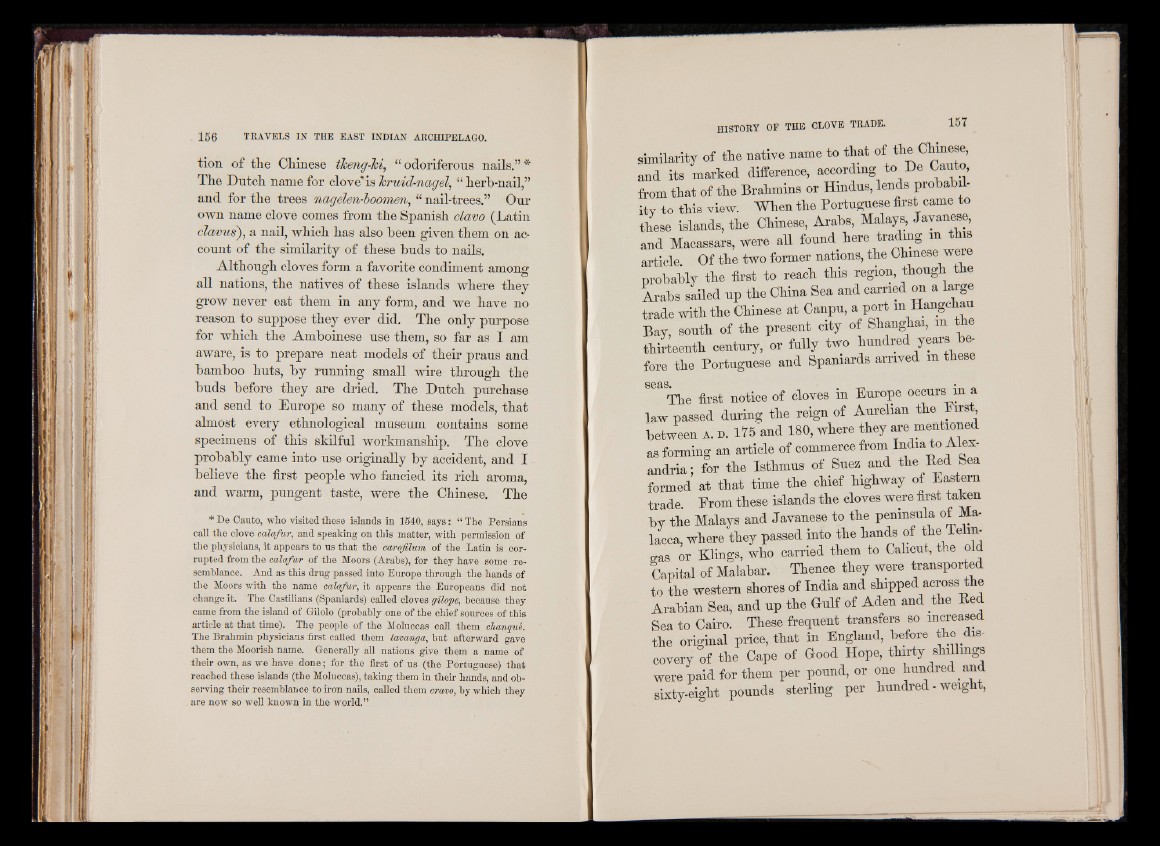
tion of tlie Chinese t/ceng-Tci, “ odoriferous nails.” *
The Dutch name for clove'is Tcruid-nagel, “ herb-nail,”
and for the trees nagelen-boomen, “ nail-trees.” Our
own name clove comes from the Spanish clavo (Latin
clavus), a nail, which has also Ibeen given them on account
of the similarity of these huds to nails.
Although cloves form a favorite condiment among
all nations, the natives of these islands where they
grow never eat them in any form, and we have no
reason to suppose they ever did. The only purpose
for which the Amboinese use them, so far as I am
aware, is to prepare neat models of their praus and
bamboo huts, by running small wire through the
buds before they are dried. The Dutch purchase
and send to Europe so many of these models, that
almost every ethnological museum contains some
specimens of this skilful workmanship. The clove
probably came into use originally by accident, and I
believe the first people who fancied its rich aroma,
and warm, pungent taste, were the Chinese. The
*De Cauto, who visited these islands in 1540, says: “ The Persians
call the clove calafwr, and speaking on this matter, with permission of
the physicians, it appears to us that the carofilum of the Latin is corrupted
from the calafur of the Moors (Arabs), for they have some resemblance.
And as this drug passed into Europe through the hands of
the Moors with the name calafur, it appears the Europeans did not
change it. The Castilians (Spaniards) called cloves gilope, because they
came from the island of Gilolo (probably one of the chief sources of this
article at that time). The people of the Moluccas call them chanqué.
The Brahmin physicians first called them lamanga, but afterward gave
them the Moorish name. Generally all nations give them a name of
their own, as we have done; for the first of us (the Portuguese) that
reached these islands (the Moluccas), taking them in their hands, and observing
their resemblance to iron nails, called them crmo, by which they
are now so well known in the world.”
similarity of tbe native name to that of ^eGbmese,
and its marked difference, according to De Canto,
from tbat of tbe Brabmins or Hindus, lends probability
to tbis view. When tbe Portuguese first came to
tbese islands, tbe Chinese, Arabs, Malays, Javanese
and Macassars, were all found here trading in
article. Of tbe two former nations, tbe Chinese were
probably tbe first to reach tbis region though tbe
Arabs sailed up tbe China Sea and carried on a large
trade with tbe Chinese at Canpu, a port m Hangcbau
Bay, south of tbe present city of Shanghai, m the
thirteenth century, or fully two hundred years e-
fore tbe Portuguese and Spaniards arrived m tbese
S6£lS* •
The first notice of cloves in Europe occurs in a
law passed during tbe reign of Aurelian the First
between a . d . 175 and 180, where they are mentioned
as forming an article of commerce from India to Alex-
andria; for tbe Isthmus of Suez and the Bed Sea
formed at tbat time tbe chief highway of Eastern
trade. From tbese islands tbe cloves were first taken
by tbe Malays and Javanese to tbe peninsula of Mar
lacca, where they passed into tbe bands of theTelm-
gas or Klings, who carried them to Calicut, the old
Capital of Malabar. Thence they were transported
to tbe western shores of India and shipped across t e
Arabian Sea, and up tbe Gulf of Aden and the Bed
Sea to Cairo. These frequent transfers so increased
tbe original price, tbat in England, before the^discovery
of the Cape of Good Hope, thirty shillings
were paid for them per pound, or one hundred and
B l l 1 1 1 nnrmds sterling per hundred - weight,